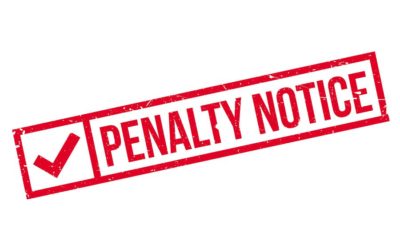Congress Passes Paycheck Protection Program Flexibility Act of 2020
On Friday June 5th, 2020, the President signed the Paycheck Protection Program Flexibility Act of 2020 (the “PPP Flexibility Act”)[1], which was passed by the House and Senate with almost complete unanimity.[2] The PPP Flexibility Act makes several significant changes to the Coronavirus Aid, Relief, and Economic Security Act (CARES Act).
Summary of provisions:
- Adds Favorable Changes to PPP Loan Forgiveness Criteria: The PPP Flexibility Act increases loan recipients’ ability to obtain forgiveness by:
- increasing the covered period from 8 weeks to 24 weeks,
- provides additional exceptions to the full-time equivalent reduction rules,
- lowers the amount of the funds that are required to be spent on payroll costs from 75% to 60%, and
- increases the deferral period for payments and interest on loans.
- Creates a 5-Year Minimum PPP Loan Term: The PPP Flexibility Act requires a minimum 5-year term for PPP loans, but this provision only applies to loans originated on or after the effective date (June 5, 2020) of the PPP Flexibility Act.
- Removes Barrier to CARES Act Provision Allowing Deferred Payment of Payroll Taxes
Need for SBA Guidance On PPP Flexibility Act
These changes provide additional flexibility for recipients to receive forgiveness and they increase the chances that recipients will be able to obtain forgiveness for most, if not all, of their PPP loans.
We will have to wait for additional SBA guidance to see how changes in PPP Flexibility Act are interpreted and implemented at the practical level and how the changes alter existing SBA guidance.
When the CARES Act was passed, the Small Business Administration began providing guidance on the origination and forgiveness of PPP loans. SBA guidance has come in the form of an expanding list of frequently asked questions and interim final rules, which are published in the Federal Register. Because the CARES Act sets forth the Paycheck Protection Program in general terms, SBA guidance greatly influences how the terms are interpreted and practically administered.
For now, here is what we know.
PPP Flexibility Act Provisions
Minimum 5 Year Maturity
Under the original terms of PPP, banks were authorized to execute loans of up to 10 years. However, prior to the PPP Flexibility Act, PPP loans had a 2 year maturity.
The PPP Flexibility Act introduces a new minimum maturity of five years for loans executed on or after the enactment of the PPP Flexibility Act (June 5, 2020). The 10 years maximum term is left intact.
However, the PPP flexibility Act allows borrowers and banks to renegotiate the maturity of loans executed prior to the enactment of the PPP Flexibility Act.[3] It is unclear if there is a deadline on when these renegotiated terms must be put in place. It is also unclear if banks will be willing to renegotiate or extend the loans unilaterally.
Extension of the Covered Period to December 31, 2020
Under the CARES Act, the covered period for issuing new loans ended on June 30, 2020. The PPP Flexibility Act changes the end of the covered period from June 30, 2020 to December 31, 2020.
Changes Related to Forgiveness of PPP Loans
Extension of the Covered Period to 24 Weeks
Under the CARES Act, loan recipients could receive loan forgiveness to the extent that the recipient spent the loan proceeds on covered expenses[4] in the “covered period.” Under the CARES Act, the covered period was 8 weeks beginning on the date of the loan disbursement by the bank. The PPP Flexibility Act increased the covered period to 24 weeks.[5]
The increase in the covered period seems to provide an additional 16 weeks for all recipients to spend their PPP loan on covered costs.
Under the CARES Act, the definition of payroll costs excluded “the compensation of an individual employee in excess of an annual salary of $100,000, as prorated for the covered period.”[6] Since the covered period was eight weeks, one major limitation on forgiveness has been that employees cash compensation was limited to 8/52 of $100,000 ($15,385). This limitation also limited owner-employees, self-employed individuals, general partners, and sole proprietors.[7] Now that the covered period is 24 weeks, you could argue that cash compensation should be limited to 24/52 of $100,000 ($46,154). Hopefully, SBA will confirm this interpretation in new guidance.
On the other hand, we will also have to wait for SBA guidance to see how the new 24 week covered period interacts with the FTE equivalent reduction.
Brief Background on FTE Reductions
Under the CARES Act, loan forgiveness is reduced based upon the ratio of the number of full-time equivalent (FTE) during the covered period to the number of FTE during the “reference period.”[8] The CARES Act did not specify how FTE equivalents were determined.
SBA Guidance spelled out that FTE equivalent is calculated by examining each individual employee and taking the average number of hours per week in the period divided by 40. Each individual’s FTE was then aggregated to determine the FTE reduction ratio, which would be multiplied by the tentative total loan forgiveness to arrive at the final loan forgiveness amount.
The CARES Act and SBA guidance provides some exceptions to the FTE equivalent reduction.
The CARES Act provides one individual exception: an employee that was offered to be rehired or to have their hours or compensation level restored, but the employee declined, does not impact the FTE reduction ratio.[9] The CARES Act also provides that “the Administrator and the Secretary of the Treasury may prescribe regulations granting de minimis exemptions from the requirements under this subsection.”
The SBA exercised this authority and provided for a few additional exceptions. Under these exceptions, the individual employee’s FTE equivalent reduction would not be counted against the loan recipient’s FTE reduction ratio for:
- Employees that were fired for cause,
- Employees that voluntarily resign, or
- Employees that voluntarily requested a reduced schedule during the covered period or the alternative payroll covered period.[10]
New Exemptions to FTE Reduction
The PPP Flexibility Act added some new exceptions to the FTE reduction analysis.
Under the PPP Flexibility Act, the FTE reduction ratio will not be impacted, if the recipient can document, in good faith:
- an inability to rehire individuals who were employees of the eligible recipient on February 15, 2020; and
- an inability to hire similarly qualified employees for unfilled positions on or before December 31, 2020.
In addition, the FTE reduction ratio will not be impacted, if the recipient can document, in good faith:
“an inability to return to the same level of business activity as such business was operating at before February 15, 2020, due to compliance with requirements established or guidance issued by the Secretary of Health and Human Services, the Director of the Centers for Disease Control and Prevention, or the Occupational Safety and Health Administration during the period beginning on March 1, 2020, and ending December 31, 2020, related to the maintenance of standards for sanitation, social distancing, or any other worker or customer safety requirement related to COVID–19.”
This provision is vague and raises many questions. For starters, is the recipient’s (i.e., the business’s) compliance with health guidelines that directly leads to reduced level of business or is it the fact that health guidelines have indirectly prevented the business (i.e., health guidelines impact on the market) from returning to the same level of business? What if the business returns to the same level of business but then the level of business falls again due to health guidelines?
Hopefully SBA guidance will address these issues.
Finally, since the FTE reduction ratio is calculated by comparing the average FTE equivalents in the covered period to the average FTE in the reference period, recipients are going to have to monitor and manage their average FTEs for 24 weeks in order to maximize forgiveness. In the alternative, they will have to ensure that they meet the safe harbor for FTE equivalent reduction.[11]
Loan Forgiveness Limitation Based upon Payroll Costs Reduced from 75% to 60%
The CARES Act provides that borrowers are eligible for forgiveness in an amount equal to the sum of payroll costs and any payments of mortgage interest, rent, and utilities. However, the SBA Administrator determined that the non-payroll portion of the forgivable loan amount should be limited to effectuate the core purpose of the statute and ensure finite program resources are devoted primarily to payroll. The SBA Administrator determined that 75 percent is an appropriate percentage in light of the Act’s overarching focus on keeping workers paid and employed. Thus, under SBA guidance, forgiveness was limited for non-payroll costs is limited to 25 percent of the forgiveness amount.[12] Subsequent, SBA guidance (and SBA’s loan forgiveness application) confirmed that the limitation was a limitation and not a prerequisite for any forgiveness (i.e., it was not a cliff).
The PPP Flexibility Act reduced this payroll cost percentage limitation from 75% to 60%. However, the language in the PPP Flexibility seems to potentially add the cliff effect (i.e., require at least 60% of loan proceeds to be spent on payroll costs):
“(8) LIMITATION ON FORGIVENESS.—To receive loan forgiveness under this section, an eligible recipient shall use at least 60 percent of the covered loan amount for payroll costs, and may use up to 40 percent of such amount for any payment of interest on any covered mortgage obligation (which shall not include any prepayment of or payment of principal on a covered mortgage obligation), any payment on any covered rent obligation, or any covered utility payment.” [Emphasis Added]
Election to End the Covered Period At 8 Weeks
Although the PPP Flexibility Act extends the covered period to 24 weeks, it also allows PPP Loan recipients to elect an 8 week covered period. This will allow recipients that have already spent their PPP funds to expedite the forgiveness process. However, it is unclear why recipients could not elect some covered period between 8 weeks and 24 weeks.
If you do not elect an 8 week covered period but you spend your funds before the end of the longer 24 week covered period, can you apply for forgiveness before the 24 weeks is over? Hopefully SBA will provide some guidance and flexibility here, but it remains to be seen.
Extension of Deferral Period Until Bank Receive Forgiveness Funds From SBA
Under the CARES Act, loan payments were deferred for 6 months from the date of the loan. Under the PPP Flexibility Act, loan payments (including principal, interest, and fees) is deferred until the amount of loan forgiveness is remitted by SBA to the lender. However, if a borrower has not applied for forgiveness within ten months from the last day of the 24 week covered period, then the borrower must begin making payments (principal, interest, and fees).
Removal of Block to Obtaining PPP Forgiveness and Payroll Tax Deferral
Overview of Change to CARES Act
Section 2302 of the CARES Act provided that certain “applicable employment taxes” were not required to be deposited with Treasury during the “payroll tax deferral period.”[13] However, this deferral was not available for taxpayers that obtained loan forgiveness for PPP loans. [14]
As a result, the CARES Act required businesses to choose between forgiveness of their PPP loan and deferral of their applicable employment taxes.[15] The Paycheck Protection Program Flexibility Act of 2020 removed the restriction that required businesses to choose between forgiveness and deferral.[16]
Now employers can receive both PPP loan forgiveness and defer payment of the “applicable employment taxes” until the “applicable date.”
Summary of Section 2302 Payroll Tax Deferral
Under CARES Act section 2302, employers are not required to make payroll tax deposits with respect to “applicable employment taxes” during the “Payroll Tax Deferral Period” until the “Applicable Date.” As long as these deferred “applicable employment taxes” are paid by the “applicable date” then they are deemed to have been deposited timely.
Section 2302 defines the Payroll Tax Deferral Period as March 27, 2020 [date of enactment of the CARES Act and ending before January 1, 2021. Thus, the applicable employment taxes arising after on or after March 27 and before January 1, 2021 are eligible for deferral.
Section 2302 defines Applicable Employment Taxes as (i) Employers share of Social Security (i.e., 6.2% of compensation as imposed by § 3111(a)); (ii) Employee and Employer Tier 1 Rail Road and Retirement taxes under § 3211 and 3221(a); and (iii) 50 percent of the Social Security tax on net earnings from self-employment income imposed under section 1401(a) (i.e., 50% of SECA).
The deferred amounts must be paid by the “appliable date.” Per Section 2302, the term “applicable date” means:
(A) December 31, 2021, with respect to 50 percent of the [deferred] amounts […], and
(B) December 31, 2022, with respect to the remaining such amounts.
If the deferred amounts are paid by the Applicable Date, then the employer is treated as having made timely deposits with respect to all such amounts.
Per an IRS list of frequently asked questions posted on April 16, 2020, the IRS intends to revise the second calendar quarter of 2020 (April – June, 2020).[17] In addition the IRS indicated that it will provided additional guidance to instruct employers how to reflect the deferred deposits and payments otherwise due on or after March 27, 2020 for the first quarter of 2020 (January – March 2020). “In no case will Employers be required to make a special election to be able to defer deposits and payments of these employment taxes.”
Deferral of the payment of the employer portion of SS and 50% of SECA over one to two years is a very generous. However, there are unanswered questions.
- What happens if a business does not rebound and cannot afford to full pay the deferred amount by each of the two applicable dates? Will penalties and interest be retroactively accrued?
- What happens if some, but not all, of the deferred applicable employment taxes are paid by December 31, 2022? Will the IRS only assess penalties and interest for the portion that was not paid by either December 31, 2021 or the remainder by December 31, 2021?
- What if the employer pays 50% by December 31, 2021, but then falls behind and cannot pay the remaining 50% by December 31, 2022? Is the portion paid by December 31, 2021 deemed to be paid timely?
- When payments are applied, are they applied to the earliest amounts due first? Or are the applied pro rata to each period within the deferral period?
Conclusion
The PPP Flexibility Act provides a significant relief and flexibility for PPP loan recipients. However, there is sufficient ambiguity in the statute that we will need to wait for SBA guidance to see how all of these additions/changes will be implemented.
Notes
[1]Paycheck Protection Program Flexibility Act of 2020, P.L. 116-[], June [5], 2020, available at https://www.congress.gov/bill/116th-congress/house-bill/7010.
[2] The House passed the bill 417-1 (May 28, 2020) and the Senate passed the bill by a unanimous voice vote (June 3, 2020).
[3] “Nothing in this Act, the CARES Act (Public Law 116–136), or the Paycheck Protection Program and Health Care Enhancement Act (Public Law 116–139) shall be construed to prohibit lenders and borrowers from mutually agreeing to modify the maturity terms of a covered loan described in subparagraph (K) of such section to conform with requirements of this section.” Section 2 (b) of PPP Flexibility Act.
[4] Payroll costs, interest on covered mortgage obligations, covered rent, covered utility payments. See CARES Act section 1106(a).
[5] In addition, the forgiveness provisions were adjusted by changing certain reference provisions from June 30, 2020 to December 31, 2020 to accommodate for the increased covered period.
[6] See CARES Act section 1102(a).
[7] See [IFR] forgiveness.
[8] [Insert statement regarding reference period] The CARES Act also provides for a safe harbor; if the safe harbor is met then the PPP loan recipient does not have to reduce their overall forgiveness amount by the FTE reduction ratio.
[9] Note for offers to rehire or restore, several conditions must be met:
- the borrower made a good faith, written offer to rehire such employee (or, if applicable, restore the reduced hours of such employee) during the covered period or the alternative payroll covered period;
- the offer was for the same salary or wages and same number of hours as earned by such employee in the last pay period prior to the separation or reduction in hours;
- the offer was rejected by such employee;
- the borrower has maintained records documenting the offer and its rejection; and
- the borrower informed the applicable state unemployment insurance office of such employee’s rejected offer of reemployment within 30 days of the employee’s rejection of the offer.
[10] See [IFR dated May 22, 2020]; [] FR [].
[11] See CARES Act section 1106 (d)(5) EXEMPTION FOR RE-HIRES (providing for elimination of the forgiveness reduction for drop in average FTEs if the employer eliminates the FTE reduction by the safe harbor period).
[12] See 85 FR 20811 (April 15, 2020).
[13]See Section 2302. For more general information on the federal employment tax deferral under section 2302 of CARES Act, see https://www.irs.gov/newsroom/deferral-of-employment-tax-deposits-and-payments-through-december-31-2020#:~:text=What%20deposits%20and%20payments%20of,and%20certain%20railroad%20retirement%20taxes.. However, please note that as of June 7, 2020, the IRS post has not been updated to account for the PPP Flexibility Act of 2020.
[14] See generally CARES Act section 1102 (loan eligibility) and 1106 (PPP loan forgiveness).
[15] See CARES Act Section 2302(a)(3):
“This subsection shall not apply to any taxpayer if such taxpayer has had indebtedness forgiven under section 1106 of this Act with respect to a loan under paragraph (36) of section 7(a) of the Small Business Act (15 U.S.C. 636(a)), as added by section 1102 of this Act, or indebtedness forgiven under section 1109 of this Act.”
[16] See PPP Flexibility Act of 2020, Section 4 – DELAY OF PAYMENT OF EMPLOYER PAYROLL TAXES.
“(a) In General.—Section 2302(a) of the CARES Act (Public Law 116–136) is amended by striking paragraph (3).
(b) Effective Date; Applicability.—The amendments made by this section shall be effective as if included in the CARES Act (Public Law 116–136) and shall apply to any loan made pursuant to section 7(a)(36) of the Small Business Act (15 U.S.C. 636(a)(36)) or section 1109 of the CARES Act.
[17] See https://www.irs.gov/newsroom/deferral-of-employment-tax-deposits-and-payments-through-december-31-2020.
[/fusion_text][/fusion_builder_column][/fusion_builder_row][/fusion_builder_container]




